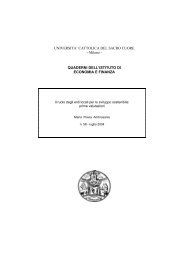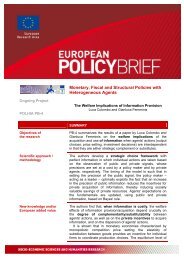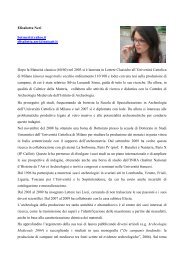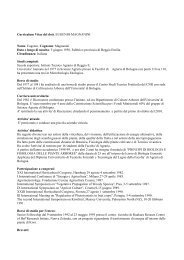UNIVERSITA' CATTOLICA DEL SACRO CUORE - Milano - Istituti
UNIVERSITA' CATTOLICA DEL SACRO CUORE - Milano - Istituti
UNIVERSITA' CATTOLICA DEL SACRO CUORE - Milano - Istituti
Create successful ePaper yourself
Turn your PDF publications into a flip-book with our unique Google optimized e-Paper software.
separation of wholesale and retail businesses. Similarly, last year in Australia the<br />
proposal of structural separation of Telstra has been extensively discussed.<br />
Apart from country-specific factors, a series of common arguments have been<br />
used by both supporters and opponents of separation. Broadly speaking, points in<br />
favour and against may be identified inside the preceding analysis of benefits and<br />
drawbacks of each approach; for this reason the contrasting arguments are only<br />
reported in a few words. Further, it also emerges quite naturally that often the<br />
advantages of structural approaches are the complement of a disadvantage of<br />
vertical integration, and vice versa. Hence, separation eliminates incentives to<br />
discrimination and squeezing arising with integration, but entails loss of<br />
economies of scope which could be exploited under integration.<br />
Other aspects still deserve a separate analysis: by way of example, it is argued that<br />
structural separation would harm competing Olo as well as final customers in so<br />
far as it leads to higher access charge 58 and the separated infrastructure company<br />
does not face competitive pressure and may become increasingly X-inefficient.<br />
Other efficiency concerns are related to the fact that, according to the specific<br />
design of separation, the infrastructure activity may not be constrained by the<br />
equity market.<br />
With reference to parity of treatment, the fear is that discrimination may be<br />
reverted, in so far as the incumbent is bound to use the separated network whilst<br />
competitors may build their own (likely more efficient) infrastructure. Further, it<br />
is felt by some commentators that the relative value of the retail and network<br />
activity would depend on arbitrary access prices, thus generating uncertainty for<br />
shareholders and putting the government into a conflicting position whenever it<br />
possess stake in one of the separated companies.<br />
A key issue is represented by the one-shot costs of structural separation; these<br />
costs obviously vary with the type of separation required, but in any case should<br />
be taken into account when assessing the desirability of separation: for example,<br />
Verizon argued before the Pennsylvania Commission that a one-time cost of over<br />
$800 million would be incurred to implement full structural separation, in addition<br />
to a continuing cost of $300 million per year.<br />
Another, possibly the most, crucial point is related to the incentives for the<br />
upstream separated activity to invest in innovation and network development and<br />
maintenance, as well as to be responsive or proactive to market needs. By way of<br />
example, uncertainty about the timing, nature and gains from innovation increases<br />
transaction costs between infrastructure owner and downstream Tlc service<br />
providers, and by consequence it may limit or eliminate completely the incentive<br />
to invest. Similarly, the controlling entity may have no incentives to invest the<br />
socially optimal amount of resources in innovation, unless some (likely imperfect)<br />
incentive mechanisms were set up by regulators.<br />
A number of minor issues could be discussed, but their implications are often<br />
dependent on the specific design of the separation proposal; a general treatment<br />
58 This economic argument is briefly treated in MACQUARIE RESEARCH EQUITIES [2003], p. 8-9.<br />
19

















